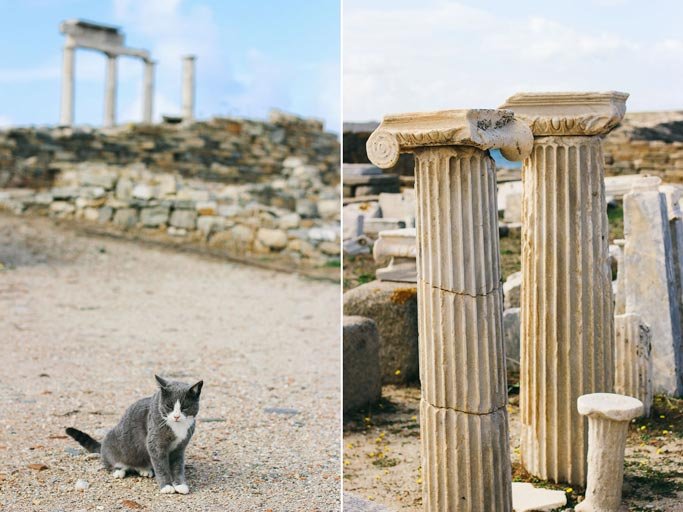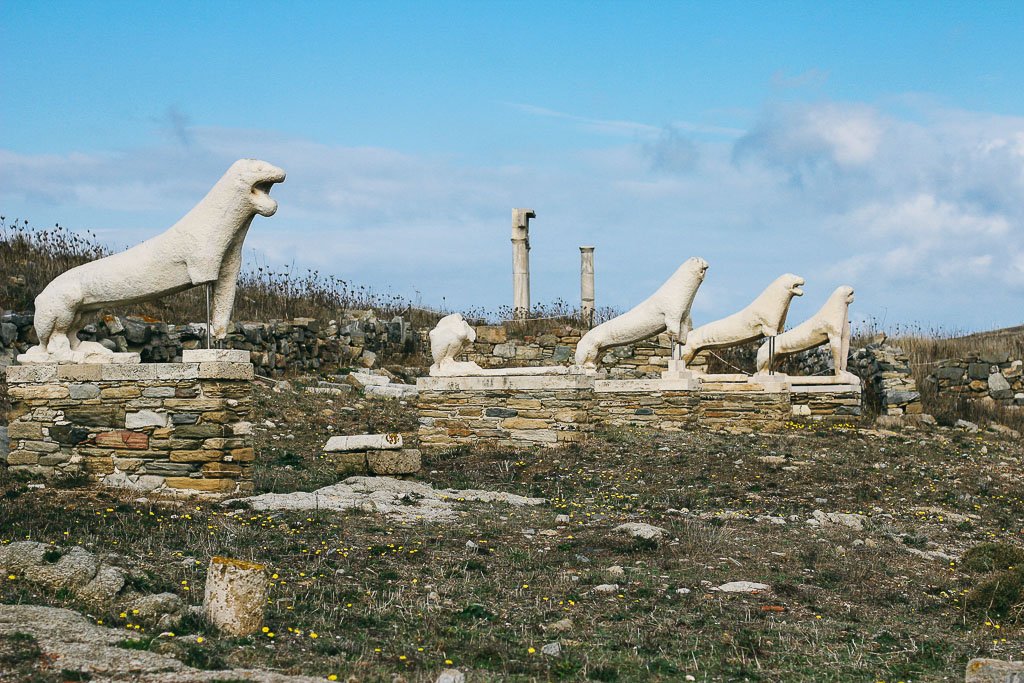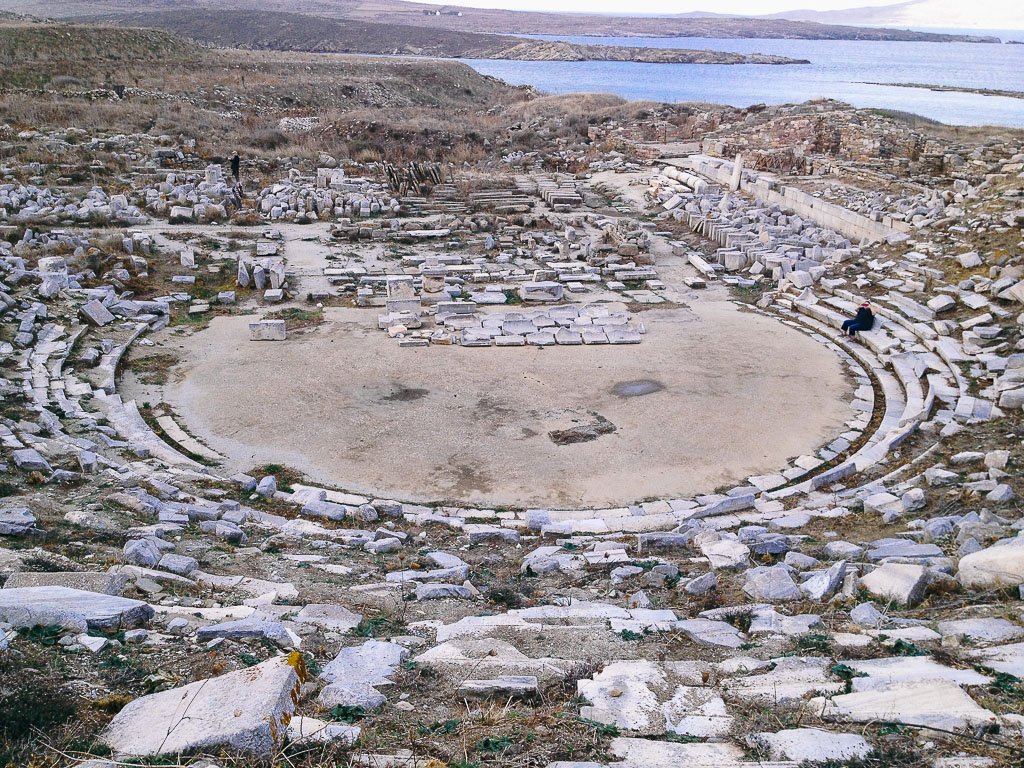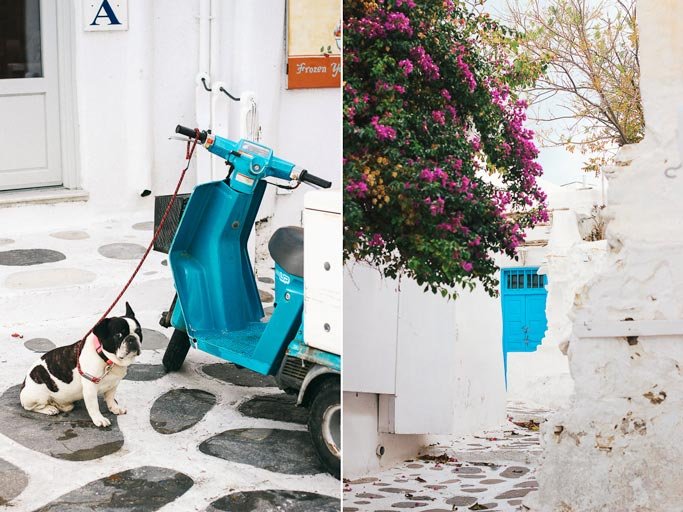GREECE PART 2: MYKONOS + DELOS
“Leto bore Apollon and Artemis, delighting in arrows, Both of lovely shape like none of the heavenly gods, As she joined in love to the Aegis-bearing ruler.”
-Hesiod, Theogony, lines 918-920
Six nautical miles off the coast of Mykonos is a barren island called Delos, where the birth of twin gods Apollo and Artemis played out, as it often does in Greek mythology, on an epic stage. Their mother, Leto, a Titan goddess and one of Zeus’ many paramours, had become pregnant after a dalliance with the ruler of gods. She was subsequently banished from mainland Greece by his wife, Hera, who was notorious for her wrathful requitals against his lovers. Especially jealous of Leto’s demure beauty, Hera banned her from giving birth on Greek soil—terra firma or any island at sea—and sent a serpent to chase her.
A frantic and forlorn Leto searched all over Greece under the great duress of labor pains, but none would help her, fearing they may incur Hera’s wrath. Clutching wearily at her womb and desperate for refuge, Leto finally came upon Delos, which was considered to be a “floating isle” and thus not attached to the land or ocean floor. It was here she gave birth, and the infant cries of Apollo (god of the sun) and Artemis (goddess of the moon) rang out across the ancient land.
In antiquity, Delos served as one of the most revered sites in all of Greece. Temples were built to honor Apollo and Artemis and pilgrims flocked here to present offerings to the gods. The island, owing to its central location, was also one of the busiest trade centers in the known world. Over time, it fell prey to attacks by armies and pirates, its once impressive sanctuaries and shrines left in ruins to fade away in history.
In present day, the island is uninhabited and largely functions as a day trip for inquisitive travelers staying in Mykonos. To visit in the off-season, on a day when rain is forecasted, is to have the place to yourself, allowing ample time to explore the panorama of windswept ruins. Fading mosaic floors, crumbling temples, beheaded statues, an overgrown amphitheater, the famous terrace of Naxian lions that ominously overlooks the now-desiccated Sacred Lake—they all add to the forgotten feel of the island—imploring the mind to imagine how bustling it must have been at the height of its distinction. An afternoon hike among these weathered ruins is, without a doubt, an archaeological experience not to be forgotten.
Mykonos, in sharp contrast to lifeless Delos, is the place to go in Greece when you’re looking for a party – or so I’m told. My family and I visited in early November, when the party-minded jetsetters had already packed up and shipped out, freeing up the island to an entirely different kind of experience. There are remnants of the high-season cosmopolitan appeal scattered about, but most of the posh places that Mykonos is known for had shuttered up for the season.
What remains in the off-months is a quaint community of locals – fishermen, chefs, artisans and retailers - who seem content with the much quieter pace. In fact, wandering around the shops, chatting with the residents, and getting lost in the maze of tiny cobbled streets (they were designed to confuse invaders) was a welcome respite from all of the historical sightseeing. We decided to embrace the lackadaisical vibe, it being the mid-point of our vacation, lingering over platters of Greek meze, trying some local ouzo, and indulging in frappes and baklava at just about every meal.
The narrow lanes of Mykonos Town weave you past colorful doors and blossoming trees with white-painted trunks, through colonies of cats, and around touristy shops, but they all eventually lead you down to the harbor, to a mélange of cafes and tavernas (one in which my sister accidentally broke a glass – Opa!!!). There you will also find a vibrant array of boats and fishing nets, a beloved local pelican named Petros, and commanding views of the hillsides clustered with white cube-shaped homes typical of Cycladic architecture.
Just around the corner is the section called “Little Venice,” a scenic embankment of restaurants along the waterfront. The famous party-oriented beaches aren’t too far away, easily reachable by ATV or bus, and you can even walk to Megali Ammos, the one closest to town. Of course, the most iconic symbol of Mykonos – the five windmills – provides an arresting backdrop to take in a Grecian sunset.
Truth be told, it wasn’t easy getting to Mykonos from Santorini in the off-season (it took a taxi ride to the Santorini airport, a turbulent flight to Athens, a 3-hour layover in the middle of a rainstorm, another turbulent flight and one more taxi ride before we arrived). But it was certainly worth it.
To be so close to the birthplace of Apollo and Artemis, you can’t help being sentient of the solar and lunar qualities present in the Mykonian skies, particularly during a storm. While the wind rips through the alleyways and the raindrops splash relentlessly onto the cobblestone, you look up into the luminous night sky and observe the harmony between the moon and the tides. Watching the indigo-tinged waves surge against the shore, it is not hard to see why the ancients deemed this little corner of the world the motherland for the keepers of the sun and moon.
MYKONOS TRAVEL NOTES:
Poseidon Hotel – gorgeous property in the outskirts of Mykonos Town; easy walk to harbor and beach; beautiful view of the windmills and sea; amazing breakfast buffet; stunning swimming pool; club/bar on-site
Delos – tour the ancient ruins on the island; 30-minute ferry ride from Mykonos; UNESCO world heritage site
Windmills – iconic symbol of Mykonos; ideal spot for photos and sunsetsLittle Venice – colorful section of town; great for strolling and taking in the view
Beaches – spend the day watching waves and catching rays (and perhaps sipping a cocktail or three)
Madoupas Café – on the harbor; super friendly staff; delicious homemade Greek fare; baked feta is heavenly
Suisse Café – good place to stop in for a refreshing frappe, Greek coffee or baklava
La Casa – great taverna in Mykonos Town for late night dinners by candlelight
Want more Greek mythology and travel stories? Check out Greece Part 1: Santorini, Greece Part 3: Delphi, and my Ode to Amphitrite.



















































